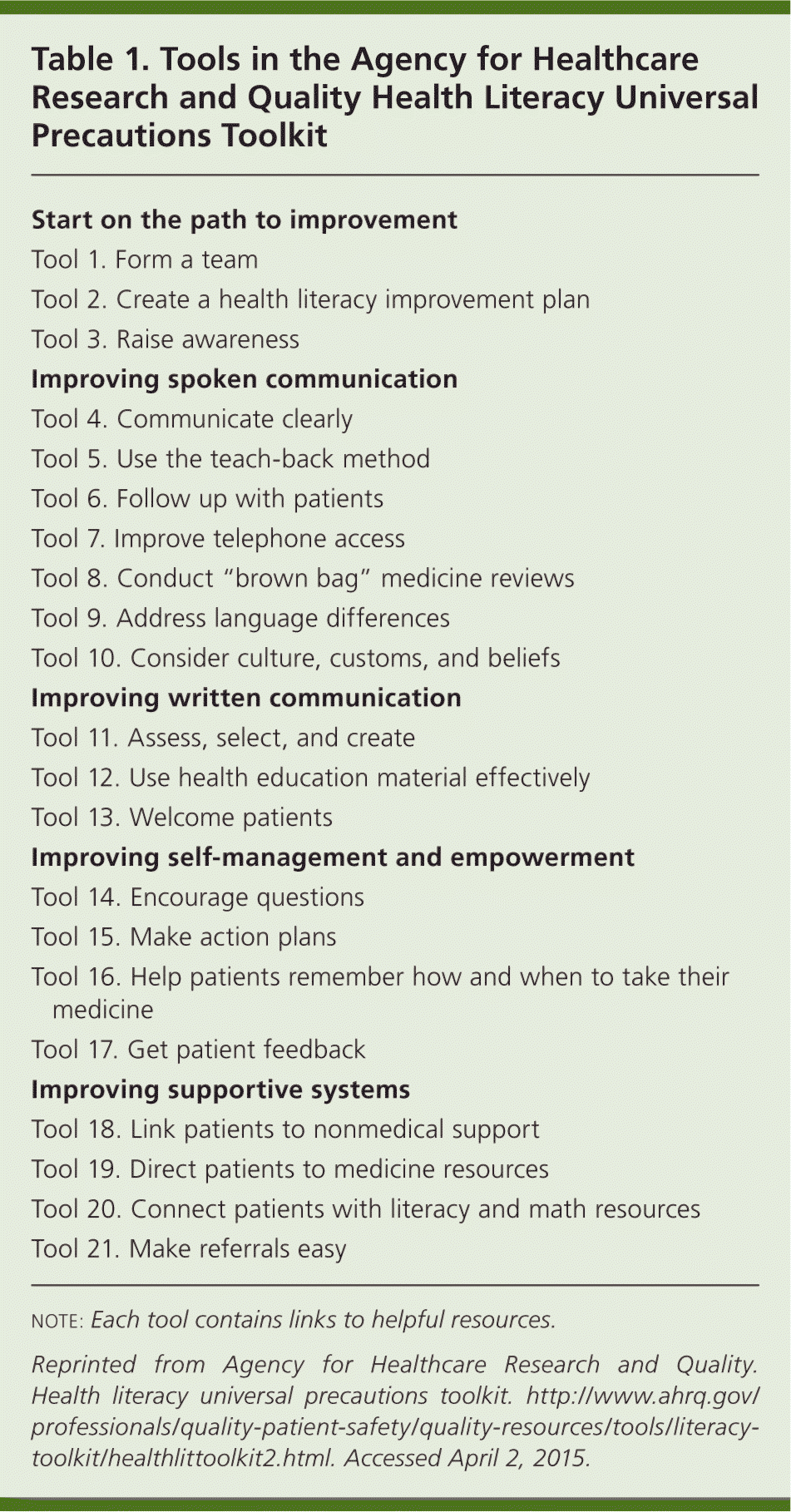
Am Fam Physician. 2015;92(2):84-90
Related article: Health Literacy in Primary Care Practice
Author disclosure: No relevant financial affiliations.
Years ago, two patients taught me the importance of communicating clearly. One was a middle-aged woman I'd been taking care of in the intensive care unit (ICU). I asked a consultant to see her, and while we were in the room with the patient, the consultant said, “I think she's doing much better. We can move her from the ICU to the floor.” After the consultant left the room, my patient asked a question I'll never forget. She asked, “I heard the hospital was full, but couldn't you get me a bed? I really don't want to sleep on the floor.” I learned that it's not just medical terms that patients may not understand. Rather, it's the entire lingo that health professionals use.
The other encounter was with the mother of a child who had strep throat. The mother seemed smart, enthusiastic, and involved in her child's care. I gave her information about strep throat and the need for antibiotics to prevent rheumatic fever, and provided a handout that had more detail. I was stunned when she told me that she could not read and had not understood much of what I had told her. I never would have suspected this from her articulate speech, or anything else about her.
In this issue of American Family Physician, Hersh and colleagues point out that a large percentage of U.S. adults (more than one-third overall and exceeding 50% in many subgroups, such as older adults) lacks the ability to understand basic health information provided by their clinicians.1 Based on those numbers, it is clear that the mother mentioned before is not the only patient who did not understand me. However, few patients have the self-confidence to speak up like she did.
Hersh and colleagues also note the substantial implications of limited health literacy, such as medication errors, failure to follow through on tests, less use of preventive care, and increased hospitalization rates. In fact, the problems associated with limited health literacy are so significant that the Institute of Medicine,2 the U.S. Department of Health and Human Services,3 and other national organizations have proposed a variety of approaches to deal with the problem.
What can physicians do to address limited health literacy and be sure that patients understand health information? The answer is twofold: practicewide changes and individual communication changes.
There are a number of recommendations about how to create a more health literacy–friendly practice. One of the most useful resources is the Agency for Healthcare Research and Quality Health Literacy Universal Precautions Toolkit, available at http://www.ahrq.gov/professionals/quality-patient-safety/quality-resources/tools/literacy-toolkit/index.html. Recently implemented in a demonstration project4 involving practices of the American Academy of Family Physicians National Research Network, the toolkit contains 21 tools (Table 15 ) that, if implemented in a practice, will improve communication with patients and help them navigate the health care system.

| Start on the path to improvement |
| Tool 1. Form a team |
| Tool 2. Create a health literacy improvement plan |
| Tool 3. Raise awareness |
| Improving spoken communication |
| Tool 4. Communicate clearly |
| Tool 5. Use the teach-back method |
| Tool 6. Follow up with patients |
| Tool 7. Improve telephone access |
| Tool 8. Conduct “brown bag” medicine reviews |
| Tool 9. Address language differences |
| Tool 10. Consider culture, customs, and beliefs |
| Improving written communication |
| Tool 11. Assess, select, and create |
| Tool 12. Use health education material effectively |
| Tool 13. Welcome patients |
| Improving self-management and empowerment |
| Tool 14. Encourage questions |
| Tool 15. Make action plans |
| Tool 16. Help patients remember how and when to take their medicine |
| Tool 17. Get patient feedback |
| Improving supportive systems |
| Tool 18. Link patients to nonmedical support |
| Tool 19. Direct patients to medicine resources |
| Tool 20. Connect patients with literacy and math resources |
| Tool 21. Make referrals easy |
Using the toolkit takes commitment and teamwork on the part of the practice, but doing so has big payoffs, including patient comprehension of health information, and improved adherence to medication regimens and follow-up plans. Practices in the demonstration project reported that they received fewer follow-up calls from patients asking for clarifications.
On an individual level, the key is communicating with patients in plain language that anyone will understand, regardless of education level or medical knowledge. Most physicians think they communicate well. However, physicians in multiple specialties (including family physicians) regularly overestimate what their patients understand.6–9 Physicians also incorrectly assume that just because a patient is highly educated, the patient understands medical terminology and concepts.
We have all been called on the phone by relatives or friends asking for a “translation” of what they were told by their physician. When we get those calls, we explain what the physician was talking about using language and terminology that our relatives or friends will easily understand. As an example, a friend once called me because his physician had ordered magnetic resonance imaging (MRI) of his knee. My friend, an electrical engineer, didn't know what an MRI was. All I had to tell him was that an MRI is a special high-tech kind of picture that doesn't require radiation.
So, perhaps the most important thing we can do to address health literacy is use this easy-to-understand approach every day, with every patient—whether it's a patient in the hospital, the parent of a sick child, or an electrical engineer.10
editor's note: Barry D. Weiss, MD, is associate medical editor for AFP.
